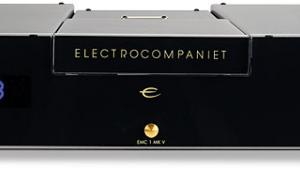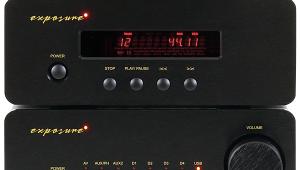Wadia 381i Cd Player (£8000)
There’s something about the look of Wadia components that says, ‘This is mighty serious’. It goes without saying that at £6500 – which is a pretty penny for an integrated player – the 381 is indeed a serious piece of work. But then Wadia CD transports and DACs (and players) have always cost top dollar, much like the products from those cutting-edge British digital specialists dCS.
So this is actually Wadia’s ‘budget’ offering, a cost-down version of the £9800 581se CD/SACD player. The 381 doesn’t play SACDs. It’s a CD-only machine. It does have a trick or two up its sleeve, however, which will be discussed imminently.
‘I’ FOR INPUTS
Wadia’s disc spinners also come in ‘i’ versions that include digital inputs and outputs. Much of what you’re paying for when buying a Wadia is the company’s proprietary D-to-A conversion methodology. (Again, as with dCS’s components.) So if you can stretch to it, it pays to spend extra on an ‘i’ version player that can form the heart of your (digital) system.
You can use the player’s DACs to decode any other digital sources you may have, such as a satellite or Freeview box, a DVD player, perhaps even your iPod if you buy one of Wadia’s revolutionary, digital-extracting iPod docks, the 170i ‘transport’ [HFN, Dec ’08.] Its 381i player – the one we’ve managed to get an exclusive look at this month, hot from the USA – comes in at a heady £8000.
I can’t quite put my finger on why Wadia products look so purposeful. Beauty is in the eye of the beholder, I suppose. And to these eyes the sober, earnest industrial design of Wadia gear gets it just right: the clean, uncluttered lines in elegant proportion hint at the solemn endeavours of the engineers to make precision audio instruments.
Apart from the loss of SACD playback, which is not an issue for many listeners who are focused instead on squeezing the best possible sound from their extensive CD collections, the 381 is to all intents and purposes a 581 at a marginally more accessible price. Digital-to-analogue conversion software features the company’s DigiMaster v2.5 upsampling algorithm, with a 1.4112MHz data rate (32x44.1kHz) and a claimed resolution of 21 bits. For inveterate tweakers there are three filters (‘algorithms’) from which to choose, which Wadia says can be used ‘to optimise the sonic performance based on system matching and personal musical priorities’ [see PM’s Lab Report for details.] Wadia describes the sound of Algorithm A as ‘robust, with extraordinary image focus’, B as providing ‘a more extended top end’ and C as giving ‘a more relaxed presentation’.
As with all of Wadia’s players, the 381 can be used directly into a power amplifier. There are built-in volume and balance controls, with volume up/down provided on the front panel as well as the rubber-backed aluminium remote handset. This obviates the necessity for a preamplifier in a fairly minimalist system, providing you can live without any analogue inputs whatsoever.
COMPUTER CONTROL
While digital level controls are usually best avoided as they sacrifice resolution, Wadia claims that this is not the case in its players. The volume is controlled within its DigiMaster upsampling algorithm, which produces a 24-bit output to the DACs and maintains high resolution even at low volume settings.
There are four digital inputs and outputs provided on the 381i – one AES/EBU digital input on XLR and three S/PDIF inputs on BNC, Toslink optical and ST (glass fibre) optical. Since the early days of its first DACs and transports Wadia has championed the use of glass optical interfaces. However, I question the usefulness of including it here and fancy that for most audiophiles a further electrical S/PDIF input would be more useful. After all, this is a player, not a standalone DAC, so the chances of anyone wanting to ‘upgrade’ by using a separate disc transport – which might have an ST optical output (they’re rare to find) – is highly unlikely. And what a pity there’s no USB input for the expedient hookup of a desktop or laptop computer.
Wadia has recently announced an upgrade programme to its separate DACs. Designed as a mezzanine board it comprises a 24-bit/96kHz ‘ClockLinked’ USB input. Fingers crossed that Wadia is able to provide this for its integrated players in the future too. In the meantime, you’ll need to have a soundcard with S/PDIF output to get audio from your computer into the 381i.
All of the 381i’s digital inputs will accept data up to 24-bits at sampling frequencies up to 96kHz. I mentioned earlier that the 381 had a trick or two up its sleeve. While it’s only a CD player, it will play MP3 and WMA files burned to CD-R/RW media – which is probably of limited interest to audiophiles, I acknowledge. What’s really rather novel, however, is the fact that it will play FLAC files up to 24/96 too. Now I’m really wishing it had a USB input, darnit.
AUDIO IMAGES
An impoverished friend, who loves visiting chez moi whenever I’ve a sumptuous piece of esoterica to listen to that’s way out of his price league (and mine for that matter) came around like a shot when he heard I had a new Wadia to audition. Clutching a bag of his favourite CDs we’d intended to spend a few hours listening to all manner of stuff, both from his collection and mine. Unfortunately for him we didn’t get to listen to very much music, as we spent the entire evening tying ourselves in knots A/B-ing the Wadia’s three filter options. It proved hard to choose between them, as preferences tended to be determined by individual recordings.
Playing familiar reference tracks that I’ve heard countless times under studio monitoring conditions, such as Diana Krall’s ‘My Love Is’ from Love Scenes [Impulse IMP12342] and ‘By The Rivers Dark’ from Leonard Cohen’s Ten New Songs [Sony 5012022], I concluded that Wadia’s descriptions of the sonic presentation offered by the three filter options are wholly defensible. The
low-order filter of ‘algorithm A’ does indeed deliver the better sense of space and image depth, the acoustic bass on the Krall track resonating in holographic fashion within the recorded acoustic. The percussive finger clicking stopped and started with cracking precision. The presentation was gloriously relaxed, with no sense of compression in the voice as it gained intensity.
Meanwhile with the over-lush Cohen recording, with its swathes of fulsome bass, ‘algorithm B’ added a sharper, crisper edge to Cohen’s gravel-laden vocal. This dark-hued recording gained a touch of sparkle that ultimately was preferable subjectively, a touch of sibilance to the leading edges of the vocal that improved the intelligibility of his mildly slurred diction.
So while it was a case of six of one and half a dozen of the other, with well-balanced recordings the ‘default’ Wadia filter proved to be the most engaging. More than merely engaging, listening to ‘humble’ CDs on the 381i proved highly infectious.
MASTERS OF REALITY
David Sylvian’s brooding ‘River Man’ from Gone To Earth [Virgin CDVDL 1] was delivered with menacing power and tension, Robert Fripp’s delicately droning electric guitar treatments sounding more ominous than ever. While a synthetic studio creation, the sonic picture delivered by the 381i was gloriously open and spacious, the subterranean bass lines once again sounding powerful and assured.
Feed the 381i a diet of audiophile recordings and it makes music come alive, creating images of musicians performing at the end of the listening room that will have the hairs on the back of your neck standing to attention. The Ensemble Modern’s Plays Frank Zappa CD [BMG 59842-2] sounded startlingly real, the musician’s performances under the direction of Jonathan Stockhammer sounding vigorous and determined. It was the illusion of open spaces between the members of the ensemble that was utterly captivating. That descriptive cliché ‘I felt that I could walk into the soundstage and touch the musicians’ has never been so appropriate.
My friend will be paying another visit imminently. He needs to return with his bag of favourite CDs. I’ve warned him he can expect it to be a very late night.
VERDICT
If you can stomach the price, then make no mistake: this is a fabulous sounding CD player. And thanks to its digital inputs you can make the 381i the heart of an audiophile system, using its DACs for all your digital sources. The absence of ‘digital glare’ makes for fatigue-free listening, while its assured bass delivery and liquid midband brings music to life when the rest of your system is of sufficient calibre.
Originally published in the August 2009 issue


























































